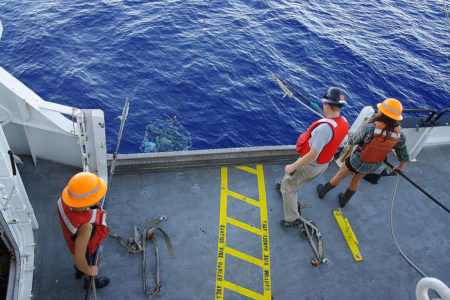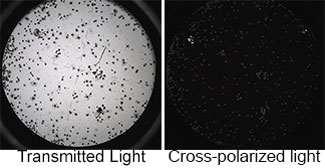
The waters were clear enough to see the CTD from 30 meters below the water’s surface. (Photo: Sarah Yang)
Outside the California Current, the last few experiments are being run aboard the Oceanus at a place Jim Bishop calls “Oceana Incognita.” The nickname came about because the location feels like the middle of nowhere and has not been observed by satellites for the past six weeks.
The contrast with the coastal waters at the Santa Cruz Basin is striking. When the top layers of water are not teeming with phytoplankton, the blue color of the water can shine through. Just as the chlorophyll in leaves absorbs the color blue, making them appear green to us, the chlorophyll in phytoplankton gives the water a more greenish hue. Had we been in Santa Cruz Basin in May, the concentrations of chlorophyll would have been 10 to 20 times higher than what we saw this trip.
Farther offshore, in areas with lower levels of plankton, the blue emerges, and that provides us with greater visibility underwater. This evening, as the CTD made its final descent into the ocean’s depths for this trip, I kept the instrument in sight for about 30 meters before it disappeared. Levels of chlorophyll are at least four times lower here than at the first station.
Behold, Plankton Poop

These images by the Carbon Flux Explorer-Cal at the Santa Cruz Basin were taken at depths of 7 meters. Shown are dozens of baby pterapods, snail-like plankton that are particularly susceptible to ocean acidification because their shells are more soluble than other calcifiers. The cross-polarized light image (right) highlights the calcium carbonate in the pterapod shells.
All four Carbon Flux Explorers were recovered today, and the data collected here illustrate the contrast between near-shore waters and offshore, oligotrophic seas, which have lower levels of microbiological activity.
A strong sign of an area with heavy biological activity is the amount of matter from microorganisms – including fecal pellets encased in calcium carbonate – drifting down into the water column. This rain of “plankton poop” is caught on camera by the Carbon Flux Explorers.
While at the Santa Cruz Basin (Station 1), the robotic float inadvertently captured images from depths of 7 meters. The happy accident showcased a “mass reproduction event” with a number of baby pterapods visible.
Back in Berkeley, the images will be analyzed and compared to the samples collected by the newest Carbon Flux Explorers.
Wrapping Up
While the amount of work and level of activity on the ship has remained high throughout this cruise, it feels to me as if the pressure has decreased. After a few days, a rhythm had developed and people began feeling more comfortable with the different tasks they needed to perform on the ship.Time was set aside today for an enjoyable “experiment” that involved sending individually decorated foam cups with the CTD down to depths of 4,200 meters. The pressure of the water at those depths – about 420 atmospheres – compressed the cups to the size of shot glasses.
It seems fitting that on our last day of testing, Phoebe Lam’s in-situ pumps were launched at sunset. The pumps are the last deployment of this trip. Once they complete their cycles and are brought back on deck, we’ll start heading off to San Francisco. We’ll likely depart before 2 or 3 a.m., putting us in San Francisco early in the morning on Tuesday, Aug. 23.

